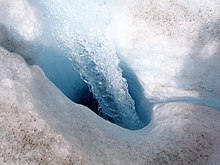Moulin (geomorphology): Difference between revisions
Reverted to revision 627987651 by 71.48.47.215 (talk): Block evasion. (TW) |
Mudflattop (talk | contribs) No edit summary |
||
| Line 6: | Line 6: | ||
They can be up to 10 metres wide and are typically found at a flat area of a glacier in a region of transverse crevasses.<ref name="eo">{{cite web |url=http://earthobservatory.nasa.gov/Newsroom/view.php?id=31613 |title=Moulin 'Blanc': NASA Expedition Probes Deep Within a Greenland Glacier |author= |accessdate=2009-06-17 |date=Dec 11, 2006 |work=[[Earth Observatory]] |publisher=[[NASA]] }}</ref> Moulins can reach the bottom of the glacier, hundreds of metres deep, or may only reach the depth of common crevasse formation (about 10–40 m) where the stream flows englacially.<ref name="eo"/> They are the most typical cause for the formation of a [[glacier cave]]. |
They can be up to 10 metres wide and are typically found at a flat area of a glacier in a region of transverse crevasses.<ref name="eo">{{cite web |url=http://earthobservatory.nasa.gov/Newsroom/view.php?id=31613 |title=Moulin 'Blanc': NASA Expedition Probes Deep Within a Greenland Glacier |author= |accessdate=2009-06-17 |date=Dec 11, 2006 |work=[[Earth Observatory]] |publisher=[[NASA]] }}</ref> Moulins can reach the bottom of the glacier, hundreds of metres deep, or may only reach the depth of common crevasse formation (about 10–40 m) where the stream flows englacially.<ref name="eo"/> They are the most typical cause for the formation of a [[glacier cave]]. |
||
Moulins are a part of a glacier's internal "plumbing" system, that carry [[meltwater]] from the surface down to wherever it may go.<ref name="bbc">{{cite web |url=http://news.bbc.co.uk/2/hi/science/nature/7780200.stm |title=Explorers dive under Greenland ice |last=Amos| first=Jonathan |accessdate=2009-06-17 |date=Dec 21, 2008 |publisher=[[BBC News]]}}</ref> Water from a moulin often exits the glacier at base level, sometimes into the sea, and occasionally the lower end of a moulin may be exposed in the face of a glacier or at the edge of a stagnant block of [[ice]]. |
[[File:Moulin on Snowbird Glacier, below the Snowbird Glacier Hut. Talkeetna Mountains, Alaska.JPG|thumb|left|A hiker peers into a massive moulin on Snowbird Glacier, in the Talkeetna Mountains of Alaska]]Moulins are a part of a glacier's internal "plumbing" system, that carry [[meltwater]] from the surface down to wherever it may go.<ref name="bbc">{{cite web |url=http://news.bbc.co.uk/2/hi/science/nature/7780200.stm |title=Explorers dive under Greenland ice |last=Amos| first=Jonathan |accessdate=2009-06-17 |date=Dec 21, 2008 |publisher=[[BBC News]]}}</ref> Water from a moulin often exits the glacier at base level, sometimes into the sea, and occasionally the lower end of a moulin may be exposed in the face of a glacier or at the edge of a stagnant block of [[ice]]. |
||
Water from moulins may help lubricate the base of the glacier, affecting [[glacial motion]]. Given an appropriate relationship between an ice sheet and the terrain, the head of water in a moulin can provide the power and medium with which a [[tunnel valley]] may be formed. The role of water in lubricating the base of ice sheets and glaciers is complex. Difficulties modelling this process led to apparently over-optimistic predictions of [[sea level rise]] by the [[Intergovernmental Panel on Climate Change|IPCC]] in the [[IPCC fourth assessment report]]. |
Water from moulins may help lubricate the base of the glacier, affecting [[glacial motion]]. Given an appropriate relationship between an ice sheet and the terrain, the head of water in a moulin can provide the power and medium with which a [[tunnel valley]] may be formed. The role of water in lubricating the base of ice sheets and glaciers is complex. Difficulties modelling this process led to apparently over-optimistic predictions of [[sea level rise]] by the [[Intergovernmental Panel on Climate Change|IPCC]] in the [[IPCC fourth assessment report]]. |
||
Revision as of 07:57, 1 November 2014


A moulin or glacier mill is a roughly circular, vertical to nearly vertical well-like shaft within a glacier through which water enters from the surface. The term is derived from the French word for mill.[1]
They can be up to 10 metres wide and are typically found at a flat area of a glacier in a region of transverse crevasses.[2] Moulins can reach the bottom of the glacier, hundreds of metres deep, or may only reach the depth of common crevasse formation (about 10–40 m) where the stream flows englacially.[2] They are the most typical cause for the formation of a glacier cave.

Moulins are a part of a glacier's internal "plumbing" system, that carry meltwater from the surface down to wherever it may go.[3] Water from a moulin often exits the glacier at base level, sometimes into the sea, and occasionally the lower end of a moulin may be exposed in the face of a glacier or at the edge of a stagnant block of ice.
Water from moulins may help lubricate the base of the glacier, affecting glacial motion. Given an appropriate relationship between an ice sheet and the terrain, the head of water in a moulin can provide the power and medium with which a tunnel valley may be formed. The role of water in lubricating the base of ice sheets and glaciers is complex. Difficulties modelling this process led to apparently over-optimistic predictions of sea level rise by the IPCC in the IPCC fourth assessment report.
See also
- Firn
- Giant's kettle
- Holocene glacial retreat
- Melt pond
- Sinkhole
- Snake coils
- Subglacial lake
- Supraglacial lake
References
- ^ Neuendorf, K.K.E., J.P. Mehl, Jr., and J.A. Jackson, J.A., eds. (2005) Glossary of Geology (5th ed.). Alexandria, Virginia, American Geological Institute. 779 pp. ISBN 0-922152-76-4
- ^ a b "Moulin 'Blanc': NASA Expedition Probes Deep Within a Greenland Glacier". Earth Observatory. NASA. Dec 11, 2006. Retrieved 2009-06-17.
- ^ Amos, Jonathan (Dec 21, 2008). "Explorers dive under Greenland ice". BBC News. Retrieved 2009-06-17.
External links
- Earth Observatory page.
- December 2006 article about a NASA expedition to Greenland moulin.
- Moulins in Greenland (Google)
